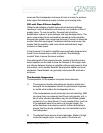
Genesis 5.3 Owners Manual Ver 2.2
19
~ÄëçäìíÉ=ÑáÇÉäáíó™
Mid-Bass Couplers
In order to create a “sound bridge” between the midrange and the
bass section, the G5 incorporates two 6.5inch metal cone mid-bass
couplers. One front and one rear firing, again working as a dipole.
Made of aluminum, this metal cone is extremely light and stiff. The
driver is hence capable of handling the huge dynamic range
demands of live music while maintaining extremely low coloration
and excellent transient response.
The Servo-bass Advantage
Very few loudspeakers use servo drive, either because most
designers think that it is too difficult to design, too expensive, or
because of the extraordinary demands a servo system makes on
the amplifier and the transducer.
The concept of the Genesis servo bass system is an easy one to
understand: It employs, an accelerometer as a sensor, to constantly
monitor the movement of the woofer cone and instantaneously
compares it to the input signal. This comparison circuit identifies any
deviation from the input and instantaneously applies a corrective
signal to compensate, thus practically eliminating the inherent
distortion of the woofer!
As an example, when you have a high-impact, low-bass signal that
starts and stops suddenly (for example a tympani), the inertia of the
woofer cone makes it slow to start moving, and then after it is
moving, the momentum of the cone makes it continue moving even
after the signal has stopped.
The sonic result is overhang, bloat, lack of tautness and definition,
and a blurring of dynamic impact. With the servo system, the circuit
senses that the woofer is not moving as fast as it should, and it
instantaneously applies much more current to make it move faster.
When the signal stops, it detects that the woofer will continue to
move when it shouldn’t and applies a counter-signal to stop the
woofer faster and more effectively than an open loop woofer could
possibly respond.
Thus, the servo-drive reduces distortion and improves transient
response by making the woofer seem massless. Typical non-servo
woofer systems have distortion levels that exceed 10% at even


















